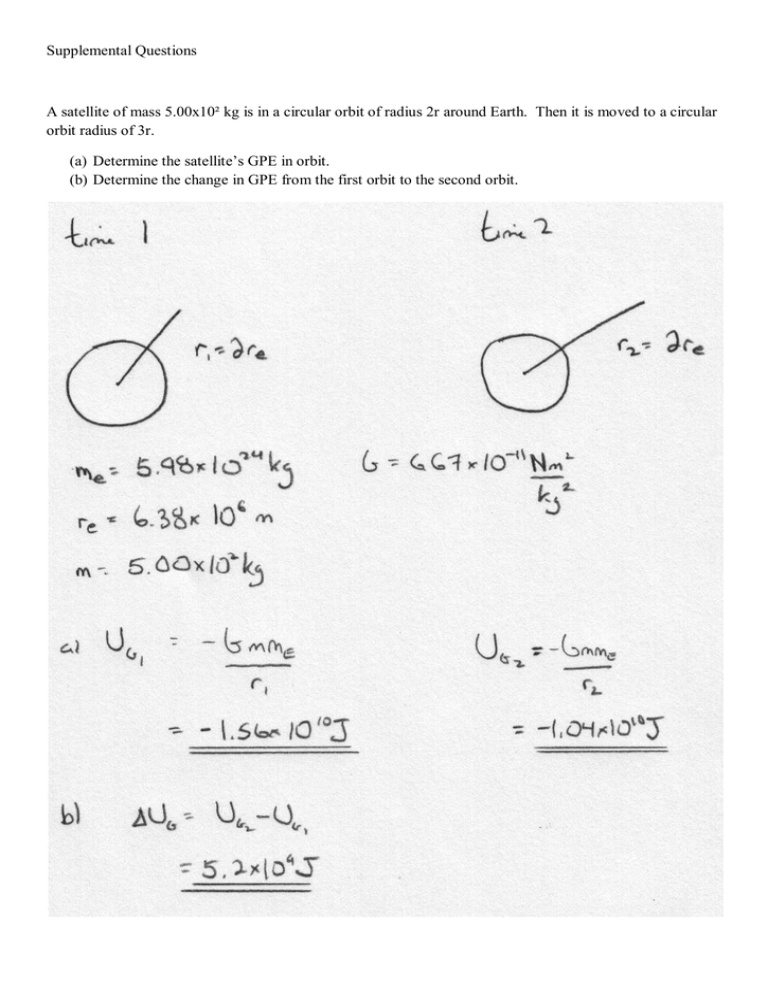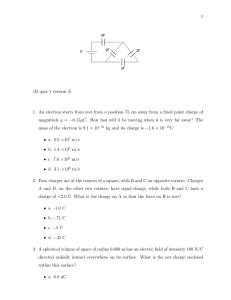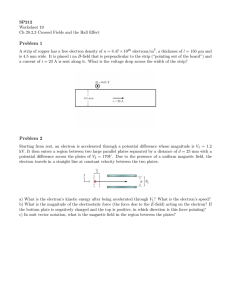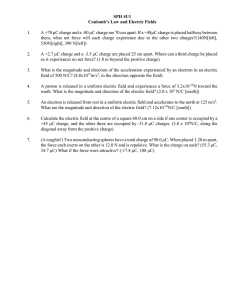Supplemental Questions
advertisement

Supplemental Questions A satellite of mass 5.00x10² kg is in a circular orbit of radius 2r around Earth. Then it is moved to a circular orbit radius of 3r. (a) Determine the satellite’s GPE in orbit. (b) Determine the change in GPE from the first orbit to the second orbit. The Moon is a satellite of mass 7.35x10²² kg, with an average distance of 3.84x10⁸ m from the centre of the Earth. (a) What is the GPE of the Moon-Earth system? (b) What is the Moon’s kinetic energy and speed in circular orbit? (c) What is the Moon’s binding energy to Earth? What is the total energy needed to place a 2.0x103 kg satellite into circular Earth orbit at an altitude of 5.0x10² km? How much additional energy would have to be supplied to the satellite in the previous question once it was out of orbit, to allow it to escape from Earth’s gravitational field? A space vehicle, launched as a lunar probe, arrives above most of Earth’s atmosphere. At this point, its kinetic energy is 5.0x10⁹ J and its GPE is (-6.4x10⁹) J. What is its binding energy? An artificial Earth satellite, of mass 2.00x103 kg, has an elliptical orbit with an average altitude of 4.00x10² m. (a) (b) (c) (d) What is its average GPE while in orbit? What is its average kinetic energy while in orbit? What is its total energy while in orbit? If its perigee (closest position) is 2.80x10² km, what is its speed at perigee? Three spheres, each with a negative charge of 4.0x10ˉ⁶ C, are fixed at the vertices of an equilateral triangle whose sides are 0.20 m long. Calculate the magnitude and direction of the net electric force on each sphere. Two small spheres of charge +5.0 μC and -4.0 μC are separated by a distance of 2.0 m. Determine the magnitude of the force that each sphere exerts on the other. A negative charge of 2.4x10ˉ⁶ C, experiences an electric force of magnitude 3.2 N, acting on the left. (a) Calculate the magnitude and direction of the electric field at that point. (b) Calculate the value of the field at that point if a charge of 4.8x10ˉ⁶ C replaces the charge of 2.4x10ˉ⁶ C. At a certain point P in an electric field, the magnitude of the electric field is 12N/C. Calculate the magnitude of the electric force that would be exerted on a point charge of 2.5x10ˉ⁷C, located at P. It takes 4.2x10ˉ³ J of work to move 1.2x10ˉ⁶ C of charge from point X to point Y in an electric field. Calculate the potential difference between X and Y. Calculate the magnitude of the electric field strength in a parallel plate apparatus whose plates are 5.0 mm apart and have a potential difference of 3.0x10² V between them. Two large horizontal metal plates are separated by 0.050 m. A small plastic sphere is suspended halfway between them. The sphere experiences an upward electric force of 4.5x10ˉ¹⁵ N, just sufficient to balance its weight. (a) If the charge on the sphere is 6.4x10ˉ¹⁹ C, what is the potential difference between the plates? (b) Calculate the mass of the sphere. An oil drop of mass 4.95x10ˉ¹⁵ kg is balanced between two large, horizontal parallel plates 1.0 cm apart, maintained at a potential difference of 510 V. The upper plate is positive. Calculate the charge on the drop, both in coulombs and as a multiple of elementary charge, and state where there is an excess or deficit of electrons. The small hole in the positive plate is allows some electrons to escape providing a source of fast-moving electrons for experimentation. The magnitude of the potential difference between the two plates is 1.2x10³ V. The distance between the plates is 0.12 m. (a) (b) (c) (d) At what speed will an electron pass through the hole in the positive plate? Is the electron pulled back to the positive plate once it passes through the hole? Explain your answer. How could the apparatus be modified to accelerate protons? Find the speed of the emerging protons in an appropriate apparatus. An electron is accelerated through a uniform electric field of magnitude 2.5x10²N/C with an initial speed of 1.2x10⁶ m/s parallel to the electric field, as shown below. (a) Calculate the work done on the electron by the field when the electron has travelled 2.5 cm in the field. (b) Calculate the speed of the electron after it has travelled 2.5 cm in the field. (c) If the direction if the electric field is reversed, how far will the electron move into the field before coming to rest? An electron with a velocity of 3.00x10⁶ m/s [horizontally] passes through two horizontal parallel plates, as seen below. The magnitude of the electric field between the plates is 120 N/C. The plates are 4.0 cm across. Edge effects in the field are negligible. (a) Calculate the vertical deflection of the electron (b) Calculate the vertical component of the final velocity (c) Calculate the angle at which the electron emerges A ping pong ball of mass 3.0x10ˉ⁴ kg hangs from a light thread 1.0 m long, between two vertical parallel plates 10.0 cm apart. When the potential difference across the plates is 420 V, the ball comes to equilibrium 1.0cm to one side of its original position. (a) (b) (c) (d) Calculate the electric field strength between the plates Calculate the tension in the thread Calculate the magnitude of the electric force deflecting the ball Calculate the charge on the ball A 1.0x10ˉ⁶ C test charge is 40.0 cm from a 3.2x10ˉ³ C charged sphere. How much work was required to move it there from a point 1.0x10² cm away from the sphere? An electron moving through a uniform magnetic field with a velocity of 2.0x10⁶ m/s [up] experiences a maximum magnetic force of 5.1x10ˉ¹⁴ N [left]. Calculate the magnitude and direction of the magnetic field. Calculate the radius of the path taken by an α particle (He²⁺ ion, of charge 3.2x10ˉ¹⁹ C and mass 6.7x10ˉ²⁷ kg) injected at a speed of 1.5x10⁷ m/s into a uniform magnetic field of 2.4 T, at right angles to the field.




